Hand, Wrist and Elbow Surgery
We perform routine minor surgeries of the hand, wrist, and elbow when nonoperative treatment fails to provide enough relief. Most of these procedures are performed as an outpatient at the Texarkana Surgery Center.
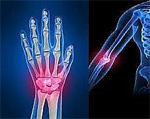
 Carpal Tunnel Syndrome is compression of the median nerve in the carpal tunnel of the wrist. A synovial sheath surrounds each tendon in the carpal tunnel. As the synovial sheaths swell with age or other inflammatory condition, increased pressure is placed on the median nerve, strangulating the blood supply to the nerve. This can result in numbness, pain, and tingling in the thumb, index, long, and ring fingers as well as weakness in pinch and grip strength. Prolonged compression can lead to permanent damage to the nerve. A nerve conduction test is usually performed to help diagnose the degree of compression. Mild carpal tunnel syndrome can be treated with NSAIDS, splints, and steroid injections. Moderate and severe carpal tunnel syndrome are often treated with carpal tunnel release. Carpal Tunnel Release is a surgical procedure which releases the transverse carpal ligament of the carpal tunnel, relieving the pressure on the median nerve and restoring its blood supply. Carpal Tunnel Syndrome is compression of the median nerve in the carpal tunnel of the wrist. A synovial sheath surrounds each tendon in the carpal tunnel. As the synovial sheaths swell with age or other inflammatory condition, increased pressure is placed on the median nerve, strangulating the blood supply to the nerve. This can result in numbness, pain, and tingling in the thumb, index, long, and ring fingers as well as weakness in pinch and grip strength. Prolonged compression can lead to permanent damage to the nerve. A nerve conduction test is usually performed to help diagnose the degree of compression. Mild carpal tunnel syndrome can be treated with NSAIDS, splints, and steroid injections. Moderate and severe carpal tunnel syndrome are often treated with carpal tunnel release. Carpal Tunnel Release is a surgical procedure which releases the transverse carpal ligament of the carpal tunnel, relieving the pressure on the median nerve and restoring its blood supply.
 Trigger Finger is a condition similar to carpal tunnel syndrome in which the synovial sheath surrounding the flexor tendon in the fingers becomes inflamed and swollen. As the sheath swells, it causes pain in the palm of the hand. As the swelling continues, it can become entrapped behind a ligamentous pulley, causing the finger to lock in a flexed position (ie Trigger Finger). Mild trigger finger can be treated with NSAIDS and steroid injections. More severe trigger finger often requires Trigger Release, an incision of the ligamentous pulley compressing the tendon sheath. Trigger Finger is a condition similar to carpal tunnel syndrome in which the synovial sheath surrounding the flexor tendon in the fingers becomes inflamed and swollen. As the sheath swells, it causes pain in the palm of the hand. As the swelling continues, it can become entrapped behind a ligamentous pulley, causing the finger to lock in a flexed position (ie Trigger Finger). Mild trigger finger can be treated with NSAIDS and steroid injections. More severe trigger finger often requires Trigger Release, an incision of the ligamentous pulley compressing the tendon sheath.
DeQuervain's Tenosynovitis is compression and inflammation of the tendon sheaths along the thumb side of the wrist. Mild compression can be treated with NSAIDS and steroid injections. When nonoperative treatment does not provide adequate relief, deQuervain's Release is performed. Incision of the ligamentous roof overlying the first dorsal compartment relieves the pressure on the tendon sheath and gives pain relief.
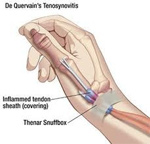
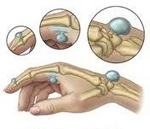 Ganglion Cysts are herniations of the pliable inner lining of joint of tendon sheath through the fibrous outer layer. The herniation forms a balloon shaped cyst filled with joint fluid that can be very painful. These can be treated nonoperatively with NSAIDs and aspiration to deflate them, but they often recur because the site of the herniation remains open. Cyst Excision is often needed to adequately remove the cyst wall and allow the herniation site to scar in. Ganglion Cysts are herniations of the pliable inner lining of joint of tendon sheath through the fibrous outer layer. The herniation forms a balloon shaped cyst filled with joint fluid that can be very painful. These can be treated nonoperatively with NSAIDs and aspiration to deflate them, but they often recur because the site of the herniation remains open. Cyst Excision is often needed to adequately remove the cyst wall and allow the herniation site to scar in.
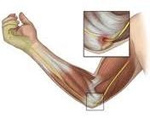 Cubital Tunnel Syndrome is a compression of the ulnar nerve at the elbow. Symptoms include numbness and tingling along the small and ring finger, and often weakness in grip strength. Because the ulnar nerve is in a fibrous tunnel that is on the back of the elbow, people with cubital tunnel syndrome often have symptoms that are made worse by bending the elbow. The degree of compression is measured by a nerve conduction velocity test. Mild compression of the ulnar nerve can be treated with NSAIDS and positioning training. More severe symptoms can be treated with Ulnar Nerve Transposition, or moving the nerve to the front of the elbow. The surgery involves cutting the flexor muscle tendon on the inside of the elbow, moving the nerve to the front of the elbow underneath the flexor muscles, and then repairing the flexor muscle tendon. Moving the nerve to the front of the elbow removes the pressure on the nerve, but restrictions are put in place for about 6 weeks to allow the flexor muscle tendon to be protected while it heals. Cubital Tunnel Syndrome is a compression of the ulnar nerve at the elbow. Symptoms include numbness and tingling along the small and ring finger, and often weakness in grip strength. Because the ulnar nerve is in a fibrous tunnel that is on the back of the elbow, people with cubital tunnel syndrome often have symptoms that are made worse by bending the elbow. The degree of compression is measured by a nerve conduction velocity test. Mild compression of the ulnar nerve can be treated with NSAIDS and positioning training. More severe symptoms can be treated with Ulnar Nerve Transposition, or moving the nerve to the front of the elbow. The surgery involves cutting the flexor muscle tendon on the inside of the elbow, moving the nerve to the front of the elbow underneath the flexor muscles, and then repairing the flexor muscle tendon. Moving the nerve to the front of the elbow removes the pressure on the nerve, but restrictions are put in place for about 6 weeks to allow the flexor muscle tendon to be protected while it heals.
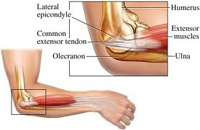 Tennis Elbow or Lateral Epicondylitis is a nonhealing microtear of the extensor muscle tendon at the lateral side of the elbow. It is often age related as a result of decreased healing response to the area. Tennis elbow can often be treated with NSAIDS, rest, and steroid injections. Cases that do not respond adequately to non-surgical treatment are candidates for Lateral Epicondylectomy. The surgery involves debriding the diseased nonhealing portion of the tendon, unroofing the hard bone on the outside of the elbow to allow exposure to underlying bleeding bone, and sometimes reattachment of the tendon to the bone. Tennis Elbow or Lateral Epicondylitis is a nonhealing microtear of the extensor muscle tendon at the lateral side of the elbow. It is often age related as a result of decreased healing response to the area. Tennis elbow can often be treated with NSAIDS, rest, and steroid injections. Cases that do not respond adequately to non-surgical treatment are candidates for Lateral Epicondylectomy. The surgery involves debriding the diseased nonhealing portion of the tendon, unroofing the hard bone on the outside of the elbow to allow exposure to underlying bleeding bone, and sometimes reattachment of the tendon to the bone.
Streaming Videos
Other Procedures Performed
|